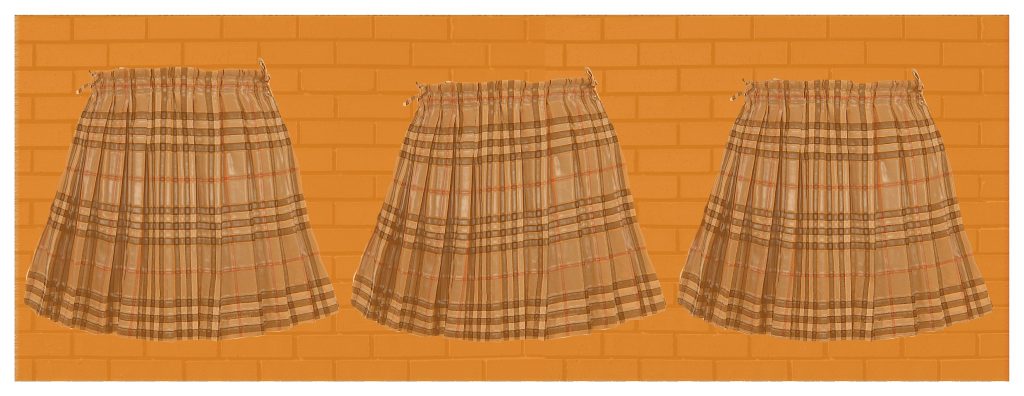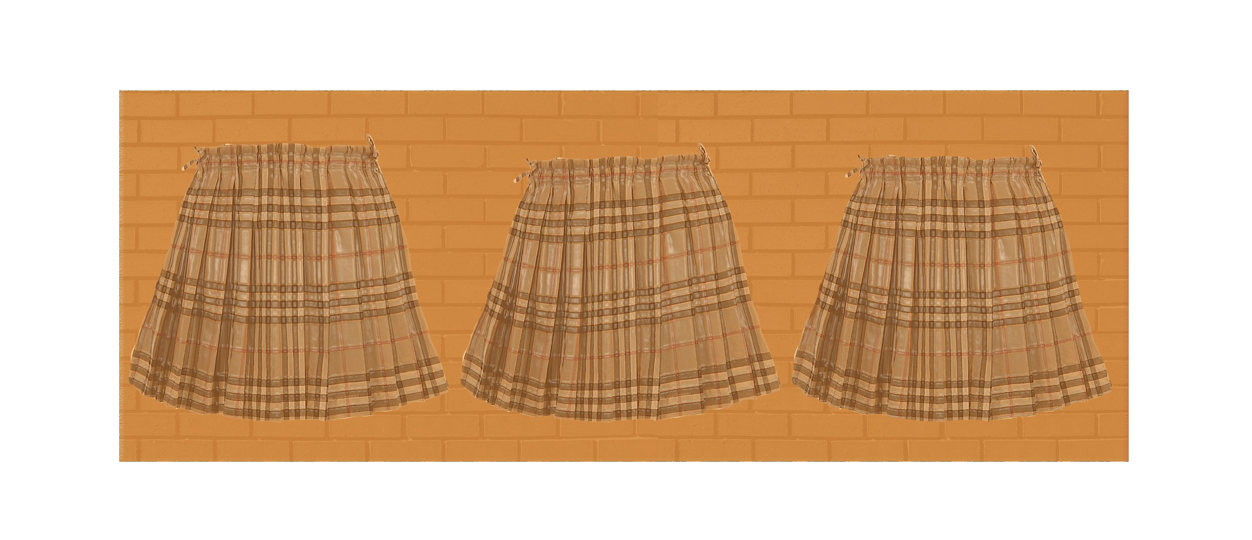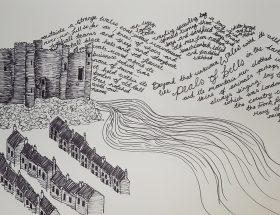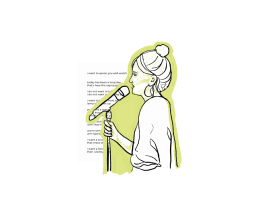Back in my hometown due to the coronavirus, in the timelessness of however many months it has been since March, I have been thinking about the past. In particular, I have been thinking about how much of our past is really our own. In academia, we tend to think of histories, especially national histories, as imagined. Our personal histories, in some ways, are similar, with our beliefs about ourselves shaping, and shaped by, the stories we tell of our pasts.
I have long told myself these sorts of self-constructing stories, as do most people, but have lately been wondering about how I tell them. Where does the imagined part come from? The obvious answer is movies and TV, the popular culture, through which we can make discordant memories coherent. Popular culture provides a familiar map for the jumbled stories of our own pasts, but the memories that do not fit these familiar narratives may be obscured in the process of this mapping. Perhaps it is necessary to use these easy maps of the popular past this way, lest we get lost in the wilderness of our overwhelming the discordance, but it is also valuable, and necessary, to interrogate the effects of this popular culture’s influence on our personal pasts, so that we can be perhaps slightly more accurate in our remembrance.
To know that we don’t know, rather than not knowing that there is more to know. In that spirit, I am going to relate some stories I have long told myself about high school, a time in our lives that is over-saturated in popular culture, and then treat myself like an unreliable narrator. The details here are true (if anonymized to avoid both embarrassments and lawsuits) but my framing of them may be misleading, and I want to figure out the degree to which that is the case. Play along from home, if you want.
The uniform for girls at my Catholic high school was a grey tartan skirt, fastened in the front, which we had to buy from one, specific company, and into which we tucked pastel, button-up shirts. Over these we could wear either sweater vests or blazers, with opaque tights or knee-high socks, and Mary Janes or ballet flats. Any rebellion more daring than, for instance, a shirt a shade darker than pastel, or a skirt that had been surreptitiously rolled, would get us sent to JUG, short for ‘Judgement Under God,’ and the school’s version of detention.
The kind of traditionalism embodied in JUG, hyper-conservatism (did God really judge us for wearing the wrong brand of skirt?) ridiculous both in itself and in the silly acronym with which it was presented, extended to all aspects of the school. This included the aesthetics of the building itself, which had gone up in the 1940s, and appeared old by the 1990s standards of its surroundings, but was designed to appear older, almost feudal. The towering, somewhat plastic-looking castle was absurd in a working-class town whose more common features were used car dealerships and billboards advertising $350 a month for blood plasma donations.
Because my high school was the only one in the area to require a uniform it was obvious where you went to school, even from a distance, if you were wearing one. This brought two broad types of attention. The first of these was mocking, the second creepy. The mockery was the more understandable of the two, aimed at the school’s pretension and exaggerated sense of its own and its students’ importance. This was a view I sympathized with, though I resented the unfairness when it was directed at me, in the uniform. I was sure then that I was nothing like my classmates in high school, and thought little of the mocking (from sidelong glances and rolled eyes, to full-on rhyming chants) beyond feeling undeserving of it.
The creepiness, though, occupied my thoughts more often, in large part because it was my more common experience wearing the uniform. I was constantly reminded of the image that the uniform conjured, the archetype that I became while wearing it, an association of concepts from the heart-shaped sunglasses on the cover of Lolita to the Britney Spears music video that had come out when I was in Kindergarten. Walking in town, my chances of being catcalled or honked at increased exponentially when I was in the uniform. Older men on the street made excuses to start conversations with me and I perfected a smiling, pretended ignorance of the things they said as they laughed, waiting for them to give up and go away, meaning to avoid their anger if I told them directly to leave me alone.
Most of these encounters happened after school, when I walked the three or four blocks between my high school and the local mall, where I wandered through stores alone.
I was almost always alone during high school. I had few friends through most of my teenage years, but tried then to see my loneliness the way it might be portrayed in a movie, underscored by melancholy music with almost as much sweetness as bitterness. I bought French fries and slushies from the food court and, as I ate them on a bench, worried that I was wasting the best years of my life. In school, my loneliness made me feel insignificant, but the attention that the uniform brought in public, which I hated and valued in equal measure, allowed me to imagine that I was pretty. If I was pretty, my loneliness could be sympathetic rather than embarrassing. My wasted youth was romantic rather than pathetic. A decadent sort of wasting.
Prettiness determined the value of each girl at my Catholic high school, my most intense, though not my sole, experience of this hierarchy. There, the uniform did not differentiate me from anyone else, while outside it could be my most striking feature. I was white and thin, two markers of conventional attractiveness, and beyond which the uniform could do the work of prettiness for me. Among my classmates, though, the standards for beauty were higher. My face was cratered with acne, my chest puny, shoulders hunched, and hair frizzy. The classrooms seemed to be air-conditioned even in the winter, so that I was constantly sneezing or sniffling. Other girls at the school were pretty in comparison with each other, I was marginally pretty only when there was no one else around with whom I could be compared. (I am both vain and confident enough to note that this changed after high school). The hierarchy was unspoken, but strict. Boys could be popular if they were funny, or rich, or athletic, no matter what they looked like. Many of the popular girls were these things as well, but for them prettiness was a prerequisite, without which these additions did not matter.
These values, about what mattered for women and girls, were specifically reinforced by our teachers. There was a history teacher at the school, funny and charismatic, one of my favorites through much of high school, who told us that women were like chocolates. The best were the ones that had been untouched before they were eaten, the most disgusting the ones that had been endlessly poked at (he told us with a wink) and abandoned, the last ones in the box. Women who were not chocolates, whom no one would want to eat, did not enter into this equation. We learned that prettiness, desirability, was a requirement for attention and discussion if you were a female. I considered myself a feminist when I was a teenager, but because I liked this teacher, I told myself that what he said must be right, or at least must be an acceptable perspective. It was not until the semester before graduation, when he told us he could no longer chaperone school dances because the low-cut dresses girls wore there were too distracting, that it dawned on me that he might have a problem with women, and his view of us might be entirely wrong. By then, the freshmen looked like children to me, and it creeped me out to hear a teacher talking about them that way.
The wider school, however, was not always so cartoonishly misogynistic. Good things happened there too. One chemistry teacher’s excitement about the symmetrical beauty of the equations she wrote on the board, and their translation to the ‘real’ world was infectious, so much so that I did not mind my bad grades in her class. There was a nervous history teacher who tried almost heartbreakingly hard to make his class interesting, but was still no one’s favorite. I liked his classes mainly because he spent most periods lecturing, rather than asking us to form discussion groups or calling on anyone to answer questions. This meant I could sit quietly and think, sometimes about the content of his lectures, without worrying about whether I would have to speak. In other classes, ones where I did have to answer questions in front of everyone, my voice always came out sounding weird from lack of use, either far too loud or far too quiet, my embarrassment heightened when I inevitably overcorrected in the other direction.
I used my voice so infrequently because I was friendless (Was this because I came in during the middle of the year, after everyone had already made friends? Or because I did not join any sports/clubs/activities? Or because I had become ugly during the summer between eighth and ninth grade? I never figured it out), and did not have anyone to talk with in between classes or at lunch. Even though my friendlessness was obvious, I was obsessed with keeping it hidden, and dreaded the points in the school’s cycle when it became plain. Gym class, for example, which we had once every six days, and during which I was invariably picked last for whatever team sport we were playing.
The worst of these, when my friendlessness became most visible, was Kairos, a mandatory four-day retreat for all seniors, spent at a conference center in the middle of nowhere. My loneliness, which I could usually escape, counterintuitively, by spending time alone, so that I could see myself through my own eyes, rather than the eyes of my classmates, became inescapable. Everyone at the retreat dismissed me as unworthy of any notice. I did not then have the strength of character to reject that judgment of my worth, when it was unanimous from all sides.
Before departing for Kairos, we had been sworn to secrecy about what would happen at the retreat. On the bus ride up, people joked about indoctrination, and cults. The retreat itself, though, was mostly boring, rather than bizarre. Our days, from eight in the morning, until ten or so at night, were devoted to speeches. We listened to other students, who had already been on the retreat, tell us how meaningful it had been for them. It was all building, implicitly, to the last night, the focal point of the rumors that had prompted speculation about cults.
The rumors about Kairos really were bizarre, and if half of them had been true the speculation about cults would not have been unfounded. The most common rumor was that, on the last night, we would be fed pie laced with drugs. When, as the sun began set on that last night, and teachers rolled in carts heaped with pie, the room erupted in whispers. One boy asked a teacher about the rumor directly and she, smiling mysteriously, looked at him and turned away, pretending not to have heard.
The pie rumor was so oddly specific it seemed possible that if one part of it was true, perhaps the rest was as well. We were sleep deprived and isolated, and had been primed to think strange things would happen that night. One girl was upset and scared, but most of us remained on a spectrum between amused skepticism and excitement regarding the possibility of drugs in the pie. Teachers pulled the girl who was upset aside, far enough away from the group that none of us could hear what they said, but presumably to assure her that, no, our high school teachers were not serving us pie laced with party drugs.
The excitement over the potentially-drugged pie turned out to be the climax of the night. Afterwards, we were sent off for the main event, but it was a letdown following all of the talk preceding it. We went in small groups to rooms on the retreat site, then sat for an hour or so in darkness lit by a single candle, and talked. The groups were divided, as many of the students at the retreat noted, like the 1985 John Hughes film The Breakfast Club. In my group, for instance, there was a football player (the Athlete), a cheerleader (the Princess), a stoner (the Criminal), a girl who is now in medical school (the Brain), and me (the Basket Case). Though I knew it already, it hurt to be reminded that my classmates thought I was such a weirdo that the teachers who assigned the groups had noticed, and decided this was my most prominent personality trait. The reminder of how the others saw me did not put me in a great headspace for the personal communication our teachers wanted us to be doing that night.
It was good, I suppose, to encourage us to talk to each other more deeply than usual, to see the full humanity of the people around us or whatever, which was the goal of the retreat, but it suffered for being a manufactured requirement to graduate. Later, when I told friends about how weird Catholic school had been, I disparagingly described the retreat as the school’s attempt to teach a bunch of privileged 18-year-olds, who had never before considered the idea, that other people were in fact people.
But was the story I told my college friends an accurate portrayal of Kairos? How much of the drug-laced pie confusion came from memory, and how much from an episode of Freaks and Geeks where something similar happened? And what about the rest of what I have written here? How much of it originates somewhere other than memory?
Looking over this, I am struck by the number of references to movies and TV in it. I expected that my memories would ‘look’ like popular culture, but not how much, in simply describing those memories I would use pop culture to explain then. Even where there is not explicit mention of any movies or TV shows, I can see the ways I have used pop culture to construct my idea of my past, and particularly that of myself in the past. When I described my ugliness, I followed it immediately with my potential to be pretty, so that I could be Marianne from Normal People rather than Meg from Family Guy. Characters like these were, implicitly, the models I used to define myself.
But what is the problem with this? What is wrong with telling the version of my past that I prefer? The details are true, so why does it matter if I want to She’s All That my memory? Tell me, what is wrong with a little spin?
The trouble, though, is that in using the past primarily as a means of understanding ourselves, according to the tropes of popular culture, we miss important things about it. In the stories I have told here, misogyny shows up in a couple of places, but racism and homophobia never do, though both were equally present at the school. In telling isolated self-narratives, along the lines of national histories meant to construct patriotic identities, we overlook the stories of the people around us, and thus the full picture of the histories that we share. The elision of others is the most troubling influence of the narrative style of pop culture on our memories. We misunderstand the past when we place ourselves at the center of it. It may not be possible for us to wholly transcend our own perspective, but we should at least keep its limits in mind. We cannot always be the main character. One friend from high school (I did have one) remembers a transcendent experience at the senior-year retreat where I was miserable, while another acquaintance remembers slurs shouted in the hallway I did not even notice. The full humanity of other people, the vast quantity and complications of other minds, is not so easy to grasp as I once thought. My past is not just my own, neither in my pop-culture tinted memory of it nor in the actual happening of it. This is not a problem to be solved, but a consequence of being alive and conscious in a world with many other people. It needs only to be remembered; none of our stories are complete.

art by Jade Fagersten





Love this article, especially as a high school classmate of the author.